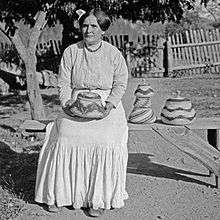Elizabeth Hickox
Elizabeth Conrad Hickox (1872/5–July 19, 1947) was a Wiyot master basket weaver and was considered one of the finest basket-weavers of her time.[1] Her baskets differ from other Lower Klamath baskets through her own unique use of shape, technique, color scheme and design.[2][3]
Elizabeth Conrad Hickox | |
|---|---|
 | |
| Born | ca. 1872/1875 Karuk Territory, California |
| Died | July 19, 1947 California |
| Nationality | Wiyot Tribe |
| Known for | Native American basketry |
| Spouse(s) | Frank Merrill, Luther Hickox |
| Patron(s) | Grace Nicholson |
Early life
Elizbeth Conrad Hickox's birth year has been given as 1872[2] and 1875.[1] Hickox's mother was Wiyot and her father, European-American.[4] It was reported that Hickox's mother, Polly, had been abducted by her later husband, Charles Conrad.[5] When Elizabeth was in her teens, she married Frank Merrill (Karuk), and they had two children together, Jessie and Bruce.[6] She later married Luther Hickox in 1895.[6] Luther Hickox owned a gold mine, was a part owner of a sawmill and later became a justice of the peace.[4] The couple enjoyed a high social status among the Karuk people, as well as financial security.[6]
Hickox lived along the Salmon River in Northern California.[1]
Artwork
Hickox used various materials to weave her baskets including grape root twining, white bear grass (Xerophyllum tenax), dyed Woodwardia fern, black maidenhair fern and dyed porcupine quills.[7] She tended to use the fern Adiantum aleuticum, a dark material in contrast to the porcupine quills dyed yellow with Letharia vulpina.[8] The choice to mostly use dark materials contrasted with the yellow was her own choice, and not subject to marketplace demands.[9] Between 1911 and 1934, she made about five baskets a year.[8]
Hickox and her daughter, Louise, weaved and sold their baskets to Grace Nicholson, who continued to buy their work even during the Great Depression.[10] Though Hickox was Wiyot, Nicholson marketed her baskets as "Karuk" because they lived in the Karuk area.[4] Before Hickox met Nicholson, she had already chosen to create fine-art baskets.[11] After Nicholson stopped purchasing baskets in 1934, Hickox continued to weave "for pleasure, utility and gift-giving."[12]
In 2020, the art of Hickox was exhibited in the exhibition Hearts of Our People: Native Women Artists at the Smithsonian American Art Museum.[13]
Death
Hickox died on July 19, 1947.[14]
Public collections
Elizabeth Hickox's baskets can be found in numerous public collections, including the following:
- Autry Museum of the American West (Southwest Museum of Los Angeles)[15]
- Denver Art Museum
- Field Museum of Natural History
- National Museum of the American Indian, Smithsonian Institution[8] the Lauren Rogers Museum of Art,[16]
- Natural History Museum of Los Angeles County.[17]
- Peabody Museum of Archaeology and Ethnology at Harvard University[18]
- University of Pennsylvania Museum of Archaeology and Anthropology
Notes
- "Elizabeth Hickox lidded baskets - Infinity of Nations: Art and History in the Collections of the National Museum of the American Indian - George Gustav Heye Center, New York". nmai.si.edu. Retrieved 2017-03-04.
- Marvin Cohodas (1999). Phillips, Ruth B. (ed.). Unpacking culture : art and commodity in colonial and postcolonial worlds. University of California Press. p. 143. ISBN 0-520-20797-1.
- Delia Sullivan, Heritage Capital Corporation, 2009, Heritage Auctions American Indian Art Auction Catalog #6029, Dallas, TX, Retrieved August 25, 2016, see page 42
- Cohodas 1999, p. 150.
- Cohodas 1997, p. 83.
- Cohodas 1997, p. 89.
- Cohodas, Marvin (2009). Heritage Auctions American Indian Art Auction Catalog #6029, Dallas, TX. Heritage Auction Galleries. p. 42.
- Rentz, Erin. "Elizabeth Hickox (Wiyot/Karuk, 1875–1947), lidded baskets". Infinity of Nations: Art and History in the Collections of the National Museum of the American Indian. Smithsonian. Retrieved 23 August 2016.
- Cohodas 1999, p. 157.
- Marks, Ben (1 July 2014). "How Railroad Tourism Created the Craze for Traditional Native American Baskets". Collectors Weekly. Retrieved 23 August 2016.
- Cohodas 1999, p. 158.
- Cohodas 1997, p. 110.
- "Hearts of Our People: Native Women Artists | Smithsonian American Art Museum". americanart.si.edu. Retrieved 2020-07-29.
- Cohodas 1997, p. 111.
- Cohodas 1999, p. 152.
- "LRMA Collection and Programs". Lauren Rogers Museum of Art. Archived from the original on 24 June 2016. Retrieved 23 August 2016.
- Cohodas 1999, p. 153.
- "Two Women: The Native Basket Weaver and the 'Curio' Dealer". Inside the Peabody Museum: March 2012. Peabody Museum of Archaeology & Ethnology at Harvard University. 2012. Retrieved 23 August 2016.
References
- Cohodas, Marvin (1997). Basket Weavers for the California Curio Trade: Elizabeth and Louise Hickox. The University of Arizona Press. ISBN 0816515182.
- Cohodas, Marvin (1999). "Elizabeth Hickox and Karuk Basketry". In Phillips, Ruth B.; Steiner, Christopher B. (eds.). Unpacking Culture: Art and Commodity in Colonial and Postcolonial Worlds. University of California Press. ISBN 9780520207974.
- Yohe, Jill; Greeves, Teri (2019). Hearts of Our People: Native Women Artists. University of Washington Press. ISBN 978-0295745794.
External links
- Elizabeth Hickox Treasure Basket (video)